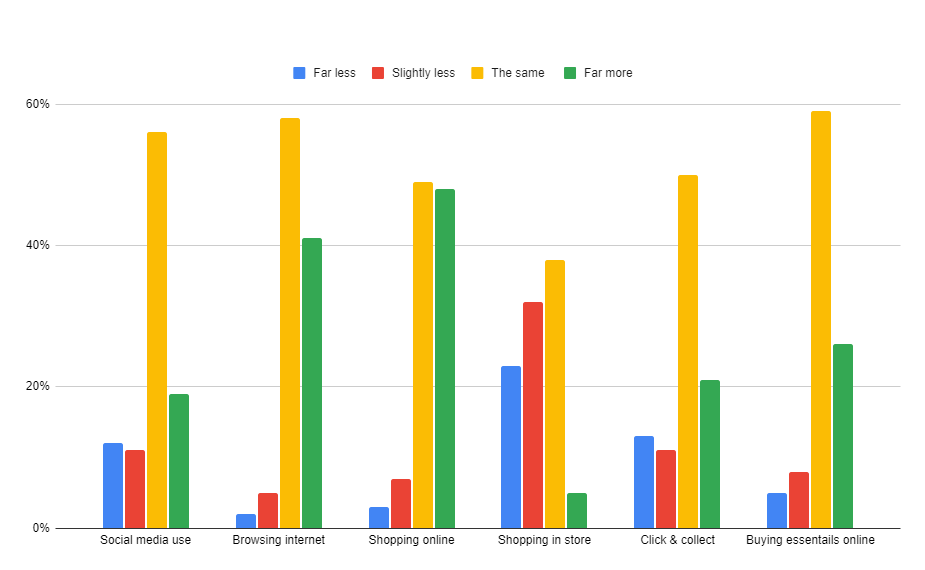The Great Consumer Shift
SHOPPING BEHAVIOURS
The pandemic has changed shopping behaviours for the long term. We have seen many shifts in consumer behaviour over the last few years, from incentives to shopping online, hurdles for retailers such as fulfillment processes and the overall customer experience.
There’s no doubt that change is everywhere for brands and retailers. Millennials are rapidly becoming the most influential segment. Consumers are now connected to each other all the time.
This has led to rising shopper expectations and heightened consumer demand. And over the past few years, we’ve seen a drastic shift in power to consumers, adding a layer of complexity to an already complex and fast-moving industry.
We’re also facing new challenges and identifying new trends—from adapting to new technologies to supply chain issues. Navigating the changing retail landscape can feel like an uphill battle.
In the article, we look at the shifts in shopping behaviours, what’s driving online spend as well as what’s preventing online purchases and the overall customer experience – so you know exactly how to plan for the future and stay ahead of your game.

Shopping behaviours from a consumer’s perspective
Shoppers are actively looking to buy the next best thing, and online shopping is a big part of everyday life now. Of the thousands of consumers surveyed in commercetool’s recent shoppers experience report, the majority made an online purchase very recently. In fact, over three quarters of shoppers (76%) made a purchase within the last three weeks.
A remarkable 41% of respondents say they are spending more time browsing the internet (hence why retailers may be seeing an increase in traffic) and over a quarter (26%) say they are using Click & Collect more often. 29% also said they are turning to online shopping to buy their essentials.
A massive 78% of retailers have said that customer frequency has increased year-on-year. Only the minority have not experienced growth.
This gives us a clear sense of how the pandemic has changed shopping behaviours in the longer term, with shoppers switching from shopping in-store to making online shopping their preference.
Consumers rating on their shopping behaviours now in comparison to one year ago:

Top Tips For Retailers
Based on these insights, it’s clear that if you want to be more competitive in today’s retail world, you have to give customers the purchase, payment and fulfilment options they expect across your in-store, online and mobile channels as well as the option purchase on several different marketplaces. Here are some top tips to implement into your business:
Tip 1: Centralise Your Data
Centralising your data in a unified commerce solution is pivotal to keeping customers at the very centre of the purchase journey, and providing a consistent brand experience across all channels. Connecting your PIM (product information manager) to your core business systems and channels (POS, ERP, WMS, ecommerce platforms, warehouses, stores, dropshippers, email gateway, payment gateway and more) not only ensures a single source of truth for product data, but connects your shopper journey seamlessly.
Store and enrich your product information in your PIM, ensuring product data is not only consistent across channels but can also be tailored per channel: product information, imagery and videos, pricing, shipping options and costs, stock availability, payment options and more.
Tip 2: Bridge The Gap Between Offline & Online Worlds
Connect your channels for a seamless, friction-free shopping experience by giving them a consistent experience wherever they chose to touch your brand.
Unify your inventory with a Distributed Order Management System to allow customers to view instore stock online. Customers are looking for real-time information when it comes to the products they need.
Make every channel shoppable and allow customers to make the purchase when and where it suits them. Whether the purchase is made on a marketplace, directed back to your ecommerce store or at a bricks and mortar retail store, ensure the journey is consistent, friction-free and designed with the customer at the centre.
Tip 3: Reimagine Your Retail Stores
Customers have been forced to adapt their shopping behaviours over the past few years, and the trend towards online shopping isn’t going away anytime soon.
Retail stores still have a massive part to play in the shopper journey, they just need to be reimagined. Remaining agile is key; adapting to changing market conditions and consumer expectations will see stores remain an important part of the shopper journey.
Enable ship from store functionality to ensure every piece of inventory is available to be sold, no matter where the order comes from, where the item is situated or where the customer is located.
By unifying inventory in a unified commerce solution, live stock counts are available online, allowing customers to check instore stock, click & collect and click & reserve.
Knowing where inventory is located also empowers store staff to make the sale, even if the item in question isn’t available in their store. Order instore, ship to home is also a powerful tool for retailers to never miss a sale.
Adopt the latest digital technologies to create showrooms, flagship stores and experiential centres. Empower customers to engage with you how and when it suits them.
Shopping Behaviours From a Retailer’s Perspective
Retailers were asked how long their shoppers are spending on their website. Almost a third of retailers (31%) say their average session duration is more than 5 minutes (meaning shoppers are researching and/or purchasing).
Yet, an almost equal number (28%) say their average session duration is 2 minutes or less. These retailers clearly have a challenge in keeping shoppers on their site.
Top Tips for Retailers
As an ecommerce business owner, you may forget to put yourself in your customer’s shoes once in a while. User experience isn’t just about how users feel when they visit your site. It also plays a huge role in how they engage with your site and, ultimately, if they end up making a purchase.
Top tips on how to keep your users engaged:
- Optimize your site speed & responsiveness
- Use a straightforward & logical content/page structure
- Use different, compelling content types
- Add internal links & suggested products
- Use clear, concise, and compelling CTAs that match the buyer’s journey
- Enable interactive site search
- Integrate live chats & chatbots
- Offer relevant store promotions
What’s important to online shoppers
In today’s way of shopping, shoppers want ease and convenience, they want access to a range of goods and they want clear ways to compare prices.
According to the Shoppers Experience report, 90% of online shoppers agree that clear product descriptions are the most important element when browsing a website. Almost in line with this, the next most important element is clear product images at 88%.
Online retail is often about selling a story, an idea that fits the needs or current whim of your audience. Obviously, online stores do not have a live store attendant (though some may offer live chat), so the sale items need to have a product description that takes the place of your best salesperson.
Shoppers want to be able to browse online and know straight away whether a product they’re interested in is right for them.
Having a PIM solution as part of your ecommerce strategy is key to having clear and consistent product data across all of your sales and marketing channels.

Nowadays, every retailer is expected to have an online web store. Simply selling products on multiple channels doesn’t create an omnichannel experience. It can be confusing to know whether or not your business is actually omnichannel.
Providing a seamless shopping experience in brick-and-mortar stores and through a variety of digital channels not only differentiates retailers from their peers but also gives them a competitive edge over online-only retailers by leveraging their store assets.
Omnichannel shoppers also tend to have larger shopping baskets and exhibit more loyalty.
So to put the whole thing in a nutshell, consumers engage more with omnichannel retailers, spend more money with them, and are more loyal, coming back more often to the physical store.
In-Store vs Online
Many shoppers scroll the web to find their products and make purchases from their phones with a click of a button. However, some still prefer to visit retailers themselves when making a purchase. In some cases, shoppers will even research the item they’re looking for online first and make the final purchase in-store.
In the recent Shoppers Experience report, shoppers were asked if they had chosen to shop in a physical store over shopping online in the past 3 months. Surprisingly, despite the clear strength of online, 73% said that have chosen to purchase in-store rather than online.
So what drives people to shop online? Shoppers are constantly looking for the best price possible and so pricing is key! 37% said they shopped online over in-store because it was cheaper.

Nowadays, every retailer is expected to have an online web store. Simply selling products on multiple channels doesn’t create an omnichannel experience. It can be confusing to know whether or not your business is actually omnichannel.
Providing a seamless shopping experience in brick-and-mortar stores and through a variety of digital channels not only differentiates retailers from their peers but also gives them a competitive edge over online-only retailers by leveraging their store assets.
Omnichannel shoppers also tend to have larger shopping baskets and exhibit more loyalty.
So to put the whole thing in a nutshell, consumers engage more with omnichannel retailers, spend more money with them, and are more loyal, coming back more often to the physical store.

Adapting to new consumer behaviours
To adapt to new customer behaviours and preferences, retailers need to evaluate their current omnichannel offerings and find opportunities to innovate and fill gaps where possible. Any additions should be clearly aligned with emerging customer needs and integrated with existing channels to support a consistent experience.
To remain relevant in this changing environment, retailers should set a North Star to guide their aspirations for customer experience, with specific goals across five actions:
Double down on digital
By boosting investments in online acquisition, retailers can partially offset diminished foot traffic in physical stores. This effort will require budget for offline media to be reallocated to digital channels. For example, paying closer attention to paid search and improving the shoppability of social channels such as featured products and clickable content on Instagram.
Inject innovation into omnichannel
To adapt to new customer behaviors, retailers will need to evaluate their current omnichannel offerings and find opportunities to innovate and fill gaps. Any additions should be clearly aligned with emerging customer needs and integrated with existing channels to support a consistent experience.
Transform store operations
The priority for many customers today is to get in and out of a store as quickly and safely as possible. Providing safe experiences, will be critical to alleviating customers anxieties.Retailers must implement policies and processes to enable safe distances, sanitize surfaces and products, and communicate proactively, clearly, and empathetically.
Reimagine the physical network
The rising volume of ecommerce transactions has forced retailers to reevaluate their network of brick-and-mortar stores and how physical locations can best support the customer experience. Retail stores still have a massive part to play in the shopper journey, they just need to be reimagined. Remaining agile is key; adapting to changing market conditions and consumer expectations will see stores remain an important part of the shopper journey.
Embrace an agile operating model
Retailers are continually having to reassess their strategies and require more real-time insights on customers than ever before. New agile operating models are needed to harness these insights and put them into action. Winning retailers are moving beyond surveys as a mechanism for customer input and toward near-real-time tracking of consumer trends and behavior shifts.
Let’s work together.
Keen to unify your inventory? Book a demonstration
with our team and discover how Comestri can transform your business today.

